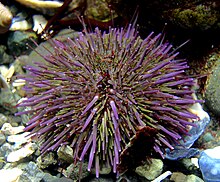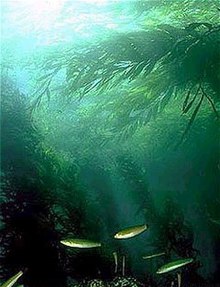Seaweed forest
A seaweed forest , also called kelp forest (after English kelp forest ) or algae forest , is an ecosystem that occurs in the riparian zones of seas of temperate latitudes . It is named after the seaweed , including in particular some large, multicellular algae from the Laminariales order . The algae native to the kelp forest are mostly brown and red algae . They provide habitat for a wide variety of fish and invertebrates and also play a role in the survival of various bird species. Predators such as sea urchins , fishing and the warming of the water, among others as part of the El Niño-Southern Oscillation, endanger the existence of the kelp forests.
features
The large algae that dominate the seaweed forest consist of three essential parts: the claw-like adhesive organ on the ground ( rhizoid ), this is followed by the flexible stem ( cauloid ) and leaf-like fronds ( phylloid ) on the water surface . At the same time, these parts form the layering into several habitats that is typical for normal forests : Above - sometimes even on the surface of the water - the fronds of larger perch form the treetop . In between, the central structure of the stalk is in the shadowy light, in which numerous species of fish cavort. Below is the dark ocean floor. Similar to coral reefs , the fight for light or the casting of shadows is an important mechanism in the competition between different species, but also between different living beings of the same kind.
Individual kelp plants reach great heights, the giant kelp ( Macrocystis pyrifera ) can be up to 45 meters long and grow from 30 to 50 cm per day. The rapid growth leads to very changeable vegetation and frequent changes in the forest between the seasons. Storms in autumn and winter tear out old fronds from the crown, allowing more light to reach the ground. It can also happen that the adhesive organ becomes detached from the ground and the seaweed begins to float around freely. The plant then floats to the surface and continues to grow until it becomes stranded or reaches warm water. It can be a gathering point for many marine animals.
ecology
The kelp forests are considered to be the submarine counterparts of the rainforests because they are also rich in biodiversity and have a similar vertical structure. The molecular biologist J. Craig Venter calculated over 1000 undiscovered species from newly found genes in the Sargasso Sea alone . As a result, several thousand previously undescribed species could still be found in kelp forests around the world. These primarily include many microorganisms of phytoplankton .
Different kelp forests
The kelp forests usually have a complex spatial structure with many coexisting genera to which the term “forest” applies best. In the East and North Pacific, the annual Nereocystis luetkeana (bullkelp) often dominates and defies stronger currents. Algae found in the kelp forest such as giant kelp ( Macrocystis ) and Nereocystis have floating bodies that hold their fronds on the water surface in order to be able to photosynthesize more effectively . The algae begin to grow in width. In addition to the crowns created by the fronds, there may be other pronounced vertical layers.
In the northern hemisphere, lower kelp forests from Laminaria species dominate, in the North Sea and Baltic Sea these are palm kelp ( Laminaria hyperborea ), fingertip ( Laminaria digitata ) and sugar kelp ( Saccharina latissima , Syn. Laminaria saccharina ). Off Alaska, if the kelp is undisturbed by sea urchins , the perennial kelp Laminaria groenlandica can gain the upper hand and take away the light from other species.
Seaweed forests on the Atlantic coast of North America do not have such high biodiversity, but are lush and support rich communities of benthic invertebrates . There they reach south to Cape Cod and appear only sporadically at the eastern end of Long Island .
In the Sargasso Sea , in the Atlantic, there is no forest of giant rods, but instead brown algae of the genus Golftange ( Sargassum , from the order of the Fucales) floating freely in the water . That is why the general designation “algae forest” or “Sargassum forest” is more appropriate. The Sargasso Sea is a special habitat for small crabs, worms and other marine animals. Plankton production is important here: it is estimated that a third of the plankton production in the Atlantic occurs in the Sargasso Sea.
Algae forest habitat
The seaweed forest offers a habitat for many living things , for example for chordates , arthropods , annelids , echinoderms , bryophytes , cnidarians , molluscs , flatworms , arm pods and sponges .
Algae are suppliers of vitamins and are also rich in protein and trace elements . Tang is an important food both for humans (especially in Japan) and for many animals . Above all, dead seaweed releases dissolved organic solids . Up to 80% of the kelp is torn loose and driven into regions with low primary production , where they are also an important source of food. Part of the carbon contained in the seaweed that was taken up by photosynthesis ends up in the deep sea and is deposited there in sediments. Seaweed forests, together with other coastal ecosystems, play a role that cannot be neglected in the function of the oceans as a carbon sink and thus for the global climate .
The mostly slowly flowing water, which is characteristic of the kelp forests, causes large accumulations of plankton and other benthic invertebrates as well as microorganisms . On the seaweed itself, preferably on the large fronds, often live epizoa , that is, ride- on animals such as sea anemones and moss animals , and numerous types of algae ( epiphytes ) settle on the stems . The seabed is lined with sponges and bog animals.
The animals that depend on the seaweed forest include herbivores and filter feeders such as mussels , bog animals, poly-bristles , sea snails and crustaceans , which larger animals can feed on in the food chain. In the forests especially falling off the coast of South Africa abalone on. The herbivores feed on the seaweed or other algae that grow in the seaweed forest.
In the central section of the seaweed forest, numerous fish species of all sizes cavort, most of which are carnivores or predators , such as seahorses and sea dragons , wrasse and filefish . Among other things, the feeds to the damselfishes belonging Black Smith ( Chromis punctipinnis ) of parasites of the Tangs. Lobsters can also be found there. Such species attract hunters like the blue shark , the great amber jack ( Seriola lalandei ) and the sunfish . There are whales that feed on the plankton sighted, rays such as eagle rays , or electric ray , looking between the Tang for prey. The giant kelp also offers hiding places and nesting sites for many sea creatures: For example, young fish and flying fish seek refuge - even in the midst of freely drifting seaweed. Dolphins, such as the white- striped dolphin, have been seen playing with pieces of floating tang. They also use the forests as hiding places. Sea otters feed, among other things, on the sea urchin, which is a major predator of seaweed. The abundant starfish also eat sea urchins. In addition, seabirds like cormorants hunt fish in the kelp forests.
distribution

The local properties of the sea are an important prerequisite for the seaweed forests: Most multicellular algae species need calm water because they would not find support if the current was too strong. It has to be rich in nutrients . Since light is required for photosynthesis , the water must be very clear, for the same reason the algae forests are in shallow water that is rarely deeper than 15 to 40 meters. They are most often found on rocky ground where the plants can easily find support. In contrast to corals , they need a low water temperature. The larger forests are in cold waters, an average temperature of 20 ° C is considered the upper limit.
They grow on the entire west coast of America , from the Aleutian Islands in Alaska to the Strait of Magellan , but never continuously because of their dependence on a rather calm current. The kelp forests off California, between San Diego and Santa Cruz and there especially in Monterey Bay are particularly pronounced . These are also the best researched, as the universities in both cities, among others, are conducting studies there.
In the Atlantic they are off the coast of Argentina to find. There are further kelp forests off the west coast of South Africa, partly in the Indian Ocean , off the south coast of Australia , off New Zealand and partly off the Antarctic .
In Europe, kelp forests are widespread from Iceland , Orkney and Norway south to the northwest coast of Africa . They cover an area of several thousand square kilometers off Norway. In the North Sea and Baltic Sea , they are restricted to coasts with a rocky seabed. The only occurrence in the German Bight is near Helgoland (nature reserve Helgoland rock plinth ). (See also the list of sea algae from Heligoland ). The underwater forests on Heligoland reach down to a maximum of 10 m water depth, in the clearer Mediterranean up to 120 m. In the Baltic Sea, for example, kelp forests can be found in the Southeast Rügen Biosphere Reserve .
Threat and exploitation of the kelp forests

The sensitive ecosystem of the submarine forests is exposed to numerous threats. Contaminated fresh water from the rivers carries pesticides , herbicides and other chemicals into the sea and into the kelp forests. This can natural balance is upset, the species diversity , and ultimately the entire ecosystem is threatened. This increasing sewage, which can be used by sea urchins as food, led to their increased occurrence, especially in the Pacific. There is also overfishing and the threat of other predators such as sea otters and cod . The natural enemies of herbivores sea urchins and even the scavengers such as sea cucumbers and brittle stars come by less often. This is a serious threat to the seaweed forest because it can hardly recover from storm damage among the many predators.
In the 18th and 19th centuries, kelp forests were intensively used on European coasts. The algae were burned and potassium carbonate (potash) was extracted from the ashes . The Orkneys in particular became an important center.
Since the 1950s, seaweed has been used so heavily as a food that there is a local risk of overexploitation . In California and Tasmania , among other places, seaweed is harvested with large ships that cut off the top fronds with scissors. When harvesting the petals, the phenomenon can occur that the brown alga Desmarestia ligulata occurs more intensely and forms a new, dense tree crown below the surface of the water, which hinders the incidence of light into the depths and thus damages the seaweed forest. The targeted creation of seaweed in an aquaculture protects the natural seaweed forests and is also more economically efficient.
The global warming threatens increasingly Tangwälder since the Tang needs cool water. For example, in a marine heat wave off the coast of Western Australia in 2011, kelp forest over a length of more than 100 km was possibly irretrievably lost. Changes in ocean currents are found off Tasmania , which also lead to a decline in the kelp forests.
literature
- Phycology Section of the German Botanical Society: Laminaria seaweed is Alga of the Year 2007 . Press release 2007.
- Paul Dayton: Annual Review of Ecology and Systematics. Ecology of Kelp Communities (PDF; 3.6 MB): 16 (1985); Pp. 215-245.
- George Karleskint et al. Introduction to Marine Biology (2009), ISBN 0495561975 .
- Ronald McPeak, Dale A. Glantz, Carole Shaw: Amber Forest the Beauty and Biology of California's Submarine Forest. Watersport, San Diego CA 1988, ISBN 0-922769-00-1 .
- Robert Steneck: Kelp forest ecosystems: biodiversity, stability, resilience and future Environmental Conservation 29 (4): 436–459 (2002) doi : 10.1017 / S0376892902000322 .
- Jeannie Baker: The Hidden Forest. Greenwillow Books, New York 2000, ISBN 0688157602 (novel).
Web links
- Marine Education Society Australia (English)
- Monterey Bay National Marine Sanctuary (English)
- Stonybrook University (English)
- Alastair Bland: The dying of primeval forests in the sea In: www.taz.de, January 4, 2018: “Scientists are worried about how huge kelp forests are disappearing off the coast. What remains is eroded wasteland on the ocean floor "
- Spektrum .de: The misunderstood reef September 28, 2019
Individual evidence
- ^ Dayton, 215.
- ↑ a b c Steneck, page 438.
- ↑ Karen Filbee-Detxer, Thomas Wernberg: Rise of turf: A New Battlefront for Global Declining Kelp Forests . In: BioScience . February 2018, doi : 10.1093 / biosci / bix147 .
- ^ John Raven: Blue carbon: past, present and future, with emphasis on macroalgae . In: Biology Letters . October 2018, doi : 10.1098 / rsbl.2018.0336 .
- ↑ Dorte Krause-Jense include: sequestration of carbon macroalgal: the elephant in the Blue Carbon room . In: Biology Letters . June 2018, doi : 10.1098 / rsbl.2018.0236 .
- ^ Marine Education Society of Australasia 4th Species Composition - Consumers , accessed January 21, 2011.
- ↑ Karleskint, page 447th
- ↑ P. Kornmann, PH Sahling: Sea algae from Helgoland - Benthic green, brown and red algae. Biological Institute Helgoland, Hamburg 1983, ISSN 0017-9957
- ↑ Southeast Rügen Biosphere Reserve - habitats .
- ↑ Thomas Wernberg et al .: Climate-driven regime shift of a temperate marine ecosystem . In: Science . July 2016, doi : 10.1126 / science.aad8745 .



